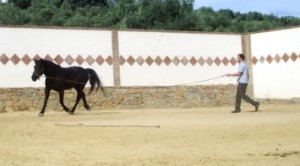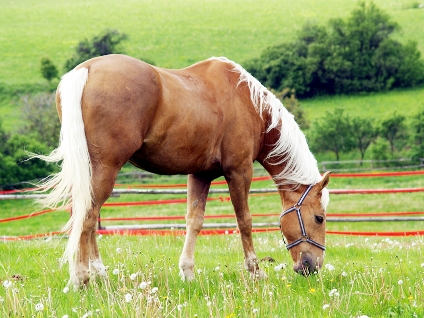 If you have ever worked with a colt on lunging, it can be one of the hardest concepts to teach, especially if the colt is a gentle, in-your-pocket type of horse. If the horse is really “hooked” on you, it’s going to feel really contradictory to your gentling process to have to make him go away from you. What you do need to establish is a cue, and follow it up with bodily actions that are “sending” actions that tell your horse it’s time to lunge. The colt will learn to recognize them and not think you are just “punishing” him or driving him away from you. At first that’s what may feel like, though, because you will have to be firm with him to get him to obey your cues.
If you have ever worked with a colt on lunging, it can be one of the hardest concepts to teach, especially if the colt is a gentle, in-your-pocket type of horse. If the horse is really “hooked” on you, it’s going to feel really contradictory to your gentling process to have to make him go away from you. What you do need to establish is a cue, and follow it up with bodily actions that are “sending” actions that tell your horse it’s time to lunge. The colt will learn to recognize them and not think you are just “punishing” him or driving him away from you. At first that’s what may feel like, though, because you will have to be firm with him to get him to obey your cues.
Here’s what I would do. If you have a round pen for assistance in maintaining a circle, position your colt to the outside edge of the circle at first. Then back away towards the center while raising your arms (point the arm holding the lunge line in the direction you want him to go, raise your other arm holding the lunge whip high in the air and towards his tail end) and giving a vocal command (I say “ck-ck-ck-ck” with clicking my tongue for walk or trot, a kissing sound for canter) and move a little behind him as you back away, so that your signals all point for him to move ahead, around the circle.
If the horse turns towards you, be VERY clear in your actions that that is not what you asked for. For instance, use the whip to slap the ground between you and him. If he keeps coming, you might need to tap him with the whip, either on the chest as low to the ground as possible if he’s aimed straight towards you, or else on the flank/hip area if he is still sideways to you. You want to use all your body language to tell him “go away and forward” and any noise, motions, arms in the air, stomps of your feet, whatever—to get him to actually GO away and forward is what you have to do in this situation.
Some colts will run from you at the blink of an eye. Other more laid-back colts need to be prodded, shooed, yelled at, or whip-swished to get them to understand. You have to do whatever is necessary to get the desired response, and a lot of horse owners are afraid to really be firm with a horse, so they stop and give up before they ever get the desired response. The process of asking softly, encouraging the horse’s obedience, then increasing the pressure and demanding obedience, and rewarding at the slightest sign of the correct action is the key to training. You shouldn’t have to always put on the pressure, once the colt learns your cue. Your cue is the “ck-ck-ck-ck”, so always start with that, softly.
Then here is the thing that will get the horse to think “Ahhhh, so that’s what they wanted me to do!”: You must reward him instantly when he does the correct behavior. Do not use treats. Treats are counter-productive because they take the focus immediately off of the training and make the horse only think of the treat. Use a release of pressure, always. When he does actually GO, lower your whip immediately, say “good boy” in a soothing higher tone, and let him slow to a stop, go up to him and pet and praise him. After a few successful times of you giving the cue, going through all the bodily actions to get him to obey, him obeying, and you instantly saying “good boy”, letting him stop, and praising him…he is going to understand what you want, and will learn to obey more quickly and effortlessly.
It will come with practice, but you have to establish your cue.


{ 1 trackback }